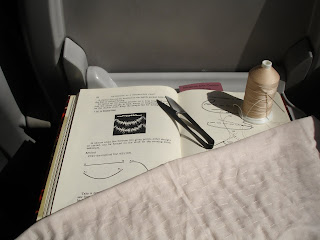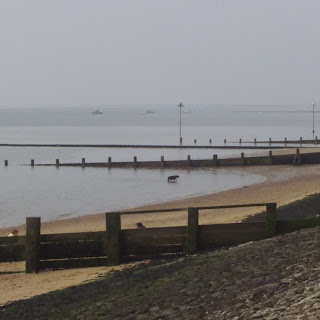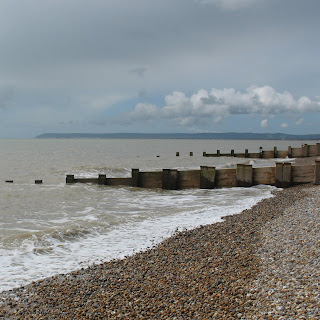
Just back from a few days in York for my birthday based around giving a gallery talk at the Quilt Museum . The train journey of only 2 hours passed quickly. I've discovered the perfect travel sewing - preparing shibori for dyeing with very large needle and stitches. Even better on the return journey thanks to Sue and present of Empress Mills 'Teddy Bear Thread' which was a bit thicker. I was consulting Anne Maile's 1963 Tie and Dye book - for all the plethora of books around, this oldie has great diagrams and instructions and is a handy travel size ( my second-hand copy also has dye stains in various places -truly a manual to consult rather than a coffee-table book)
 Ian was also reading... a military history book(what a surprise)
Ian was also reading... a military history book(what a surprise) On our arrival , the first thing we saw was the daffodils and cherry trees in full bloom around the city walls - spectacular.
On our arrival , the first thing we saw was the daffodils and cherry trees in full bloom around the city walls - spectacular.I had a very warm welcome at the Quilt Museum, such a wonderful setting for both traditional and contemporary quilts. During our stay we spent most of our time looking around York Minster (more about that in another post) and exploring the 'snickelways' between some memorable meals at Rustique(twice!), Ate O clock, Meltons Too, and Cafe No 8 with Alistair and Maggie joining us for dinner- lovely to see them. The Rhubarb and custard pavlova with rhubarb and custard ice cream was to die for - having seen it on the menu , I knew I had to budget my appetite with no starter and it was worth it!
 I also had to honour my part of the birthday bargain in visiting a military museum ( as Ian had gone to QuiltFest for his birthday) Wasn't too bad ( I made some quite intelligent comments apparently) and as a reward Ian bought me this millifiori necklace spotted through the window of 'Monkey Puzzle' on our evening perambulations. What a sweetie (and Ian's not bad either!)
I also had to honour my part of the birthday bargain in visiting a military museum ( as Ian had gone to QuiltFest for his birthday) Wasn't too bad ( I made some quite intelligent comments apparently) and as a reward Ian bought me this millifiori necklace spotted through the window of 'Monkey Puzzle' on our evening perambulations. What a sweetie (and Ian's not bad either!)






 However it does have its compensations - apart from much more light , we can now see to the other side of the river. While consulting scientific journals in the upstairs office, I've watched fascinated as the boats appear and disappear with the tides and the patterns in the mudbanks change.
However it does have its compensations - apart from much more light , we can now see to the other side of the river. While consulting scientific journals in the upstairs office, I've watched fascinated as the boats appear and disappear with the tides and the patterns in the mudbanks change.



 Deep breath and then I tackled the main section itself- and it worked!! Very satisfying.
Deep breath and then I tackled the main section itself- and it worked!! Very satisfying. 
 I started with the 'Toile' (about 12 inches square). Besides the Liquitex Heavy Body acrylic I normally use , I was also experimenting with Golden fluid acrylics, especially their interference colours, mixing them with acrylic medium to achieve a more watercolour-like effect. I also used micaceous iron oxide in the foreground for the glint of the gravel.
I started with the 'Toile' (about 12 inches square). Besides the Liquitex Heavy Body acrylic I normally use , I was also experimenting with Golden fluid acrylics, especially their interference colours, mixing them with acrylic medium to achieve a more watercolour-like effect. I also used micaceous iron oxide in the foreground for the glint of the gravel.












 Next steps - design process. Having attempted some rather unsatisfactory sketches trying to combine elements I liked from both Southend and Bexhill photos, I resorted to combining images in Photoshop. I'd had a go at this earlier with one of my Honesty pieces but I got on better once Ian showed me how to resize images before doing cut and paste.
Next steps - design process. Having attempted some rather unsatisfactory sketches trying to combine elements I liked from both Southend and Bexhill photos, I resorted to combining images in Photoshop. I'd had a go at this earlier with one of my Honesty pieces but I got on better once Ian showed me how to resize images before doing cut and paste. 


 In 2005 I made this Journal quilt of the groynes at Southend - fabric doubled over with bondaweb between then sections and slits cut out and the whole stucture inserted in a slit in fabric to give 3d effect
In 2005 I made this Journal quilt of the groynes at Southend - fabric doubled over with bondaweb between then sections and slits cut out and the whole stucture inserted in a slit in fabric to give 3d effect







